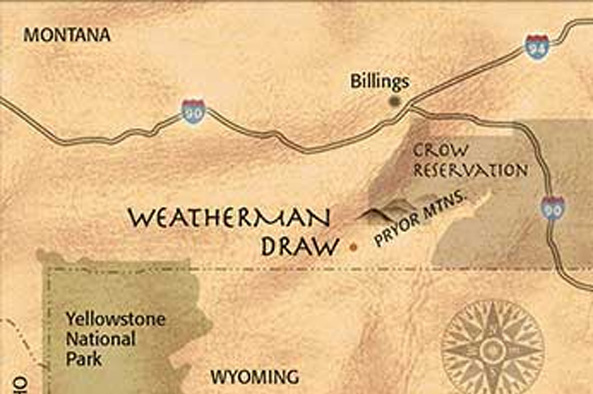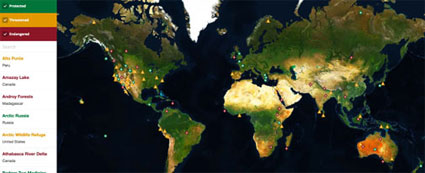
Weatherman Draw
| Status | Protected |
| Country | United States |
| Report By | Amy Corbin |
| Posted | September 1, 2001 |
| Updated | September 1, 2001 |

Weatherman Draw in southcentral Montana is a valley that contains the largest collection of Native American rock art on the continent. A landmark agreement between the National Trust for Historic Preservation, the Anschutz Exploration Corporation and the Department of the Interior will save this sacred landscape from invasion by machines, barbed wire fences, security guards, and vandalism. Jimmy Arterberry, a Comanche preservation leader who testified against oil drilling, explained: “This isn’t just some place on a hill; this is a living spiritual center. The church is alive here.”
The Land and Its People
The art in Weatherman Draw dates back over 1,000 years and consists of multi-hued drawings of shields, animals and human figures. Particularly intriguing are the shields that have heads and feet-perhaps representing specific individuals who can be traced from Mexico. Crow historian Howard Boggess writes: “The Art is alive and consecrated by the people who painted this work as they put their blood and sweat into each piece of work.” It is also known as the “Valley of the Shields” or the “Valley of the Chiefs” and was historically a place of peace where many tribes, including the Comanche, Northern Arapaho, Northern Cheyenne, Eastern Shoshone, Crow, and Blackfeet, would gather in the winter. The valley was used for vision quests, burials, prayers, and gathering medicinal plants. The exact location of Weatherman Draw and the contents of its rock art remained unknown to the general public until very recently. The wildness of the terrain kept even many tribal members away from large concentrations of the art, but the valley was catapulted into the national spotlight in 2001 as a prime example of the Bush administration’s close ties to the oil industry. The situation at Weatherman Draw reveals the dilemma that many native cultures face in protecting sacred sites: is it better to reveal the location and the sacred characteristics of an area in order to protect it, even if that publicity might lead to disturbance? Arterberry said, “We decided to try to protect it at all costs.”
Threat
Phil Anschutz, a billionaire businessman and Republican donor, waited since 1997 for a decision on his company’s permit application to the federal Bureau of Land Management (BLM). Anschutz wanted to drill for gas and oil in Weatherman Draw, expecting to find 10 million barrels of black gold. Just 12 days after the Bush administration took office, the BLM approved the exploration permit, prompting 10 tribes, Congressional Democrats, the Sierra Club, and the National Trust for Historic Preservation to question the BLM’s abrupt decision. Some politicians have shown an extreme lack of sensitivity to the concept of sacred land. During the June 6, 2001 House Resources Committee hearing Rep. Joel Hefley (R-OK) said, “it is interesting…the way Indian tribes oftentimes…come up with something that all of a sudden is sacred ground … I would be very interested to know … how long this has been the Valley of the Chiefs. Is this a modern thing or is this a long time thing?”
The BLM issued a permit based on an Environmental Assessment, a less stringent process than an Environmental Impact Statement. Exploratory drilling would have included road construction, thus opening the isolated area to traffic and vandalism. Already, the areas that are open to public access have graffitti and bullet holes in the petroglyphs. Due to opposition from tribes and other groups, the BLM stipulated that there should be a fence around the rock art areas and a security guard. However, tribal representatives maintain that the only way to protect Weatherman Draw is to keep it off limits.
Solution
The National Trust for Historic Preservation, the Sierra Club and 10 tribes appealed the BLM’s decision to approve the exploratory well to the Interior Board of Land Appeals within the Department of Interior. The Trust entered into negotiations with Anschutz and the Department of the Interior, which resulted in an April 23, 2002 agreement whereby Anschutz agrees to turn over its leases to the Trust. The Trust will simply hold the leases until they expire. Thus the appeal has been withdrawn and the Bureau of Land Management will “use its discretion” to not issue further leases until a new resource management plan is released in 2004. “Today’s announcement of an agreement proves victorious for the Crow Tribe and other Tribes who have long held the Weatherman Draw area as a significant religious and cultural site,” says Clifford Birdin Ground, Sr., Chairman of the Crow Tribe. The unusual agreement between a nonprofit conservation group, a corporation and the government reveals the huge impact of media attention on a sacred site conflict. Weatherman Draw was featured in national newspapers and Time magazine as a case study in the Bush administration’s ties to the oil industry. This, along with a coordinated effort between several tribes and nonprofits, resulted in a large-scale victory.
However, the long-term future of Weatherman Draw is still not secure. As with other sacred sites, Weatherman Draw has been determined to be eligible for inclusion on the National Register of Historic Places, but the BLM has failed to fulfill its statutory duties under the NHPA by not managing or maintaining Weatherman Draw in a way that considers the preservation of all of its historic and cultural values. BLM also failed to consider the effect of the project on the traditional religious and cultural values of native communities. In the long term, the BLM needs to re-examine the resource management plan for the entire area, specifically barring all types of drilling and not issuing any new leases. In 2001, HR 2085, “The Valley of Chiefs Native American Sacred Site Preservation Act of 2001,” was introduced, but it never left committee.
For more information, contact:
Anita Canovas, National Trust for Historic Preservation, (202) 588-6035
Jimmy Arterberry, Comanche Nation, (580) 492-3754
Resources
News coverage of the Weatherman Draw agreement: the National Trust for Historic Preservation (April 23, 2003) press release, and reports by the Associated Press, the Los Angeles Times and Indian Country Today.
Weatherman Draw and sacred land issues were the focus of the 2nd Annual Native American Issues Conference at Montana State University-Bozeman in March 2002; an Indian CountryToday article gives an account of the issue and the response of tribal leaders.
Read the Time Magazine article: “Crossing the Divide: An oil company confronts the ghosts of sacred tribal land” July 8, 2001.
Continue Exploring Sacred Sites
 Explore a world of sacred lands and discover more than 100 site reports using our interactive map.
Explore a world of sacred lands and discover more than 100 site reports using our interactive map.